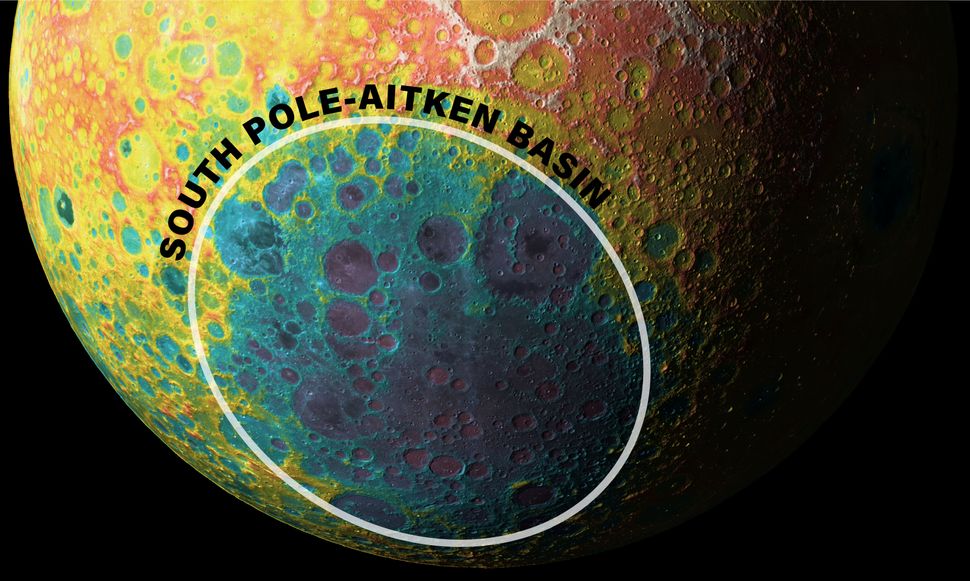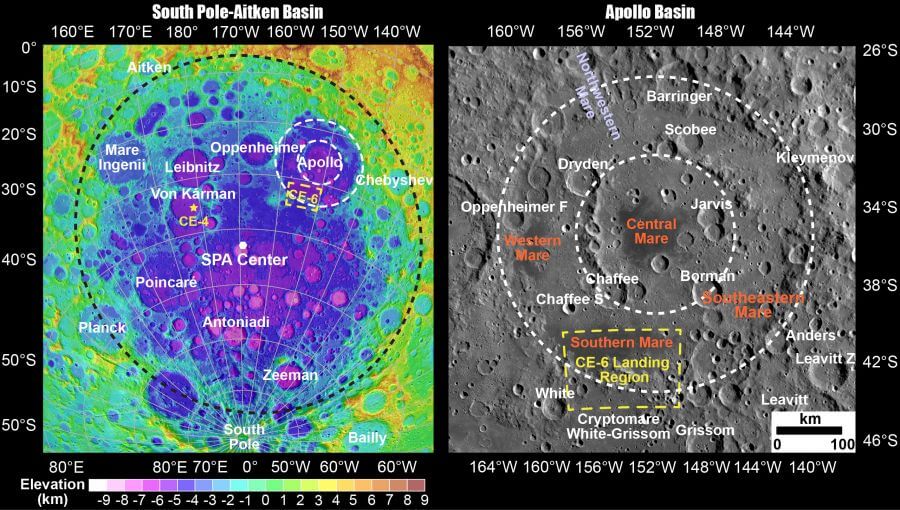
China’s Chang’e 6 probe to the moon’s far side has a big lunar mystery to solve (Image Credit: Space.com)
China’s Chang’e-6 mission, currently on its way to retrieve a sample of material from the far side of the moon, will test theories of why the lunar near and far side are so different.
Having launched on May 3, Chang’e-6 is expected to land in early June within the Apollo double ring impact basin, which lies inside the even larger South Pole–Aitken basin (SPA). The immense SPA is the largest impact feature of its kind in the solar system, spanning 2,400 by 2,050 kilometers (1,490 by 1,270 miles) in area; it was formed some 4.3 billion years ago, which is very early in the history of the solar system. Though Apollo is younger, it is also the largest impact site to be superimposed on the SPA. Apollo sports a double-ringed structure, with its inner ring of mountain peaks having a diameter of 247 kilometers (153 miles) and an outer ring about 492 kilometers (305 miles) across.
Related: China’s Chang’e 6 mission to collect samples of the far side of the moon enters lunar orbit (video)
As the first sample-return mission to the far side, Chang’e-6 aims to bring back to Earth about 2 kilograms (4.4 pounds) of precious lunar material. The far side is a relatively unknown place; its mystery is also enhanced by the fact that we cannot see it from Earth. It was only photographed for the first time by the Soviet Luna 3 spacecraft in 1959. And with this photograph in hand, scientists around the world were amazed to learn how different looking the far side of the moon is in comparison to the side we’re familiar with. While both the near and far side sport a multitude of craters, the near side also displays vast, volcanic plains called lunar maria, which create impressions like the “man in the moon” shape and cover something like 31% of the whole near-side area.
Meanwhile, the far side is quite the opposite. It’s only about 1% covered by volcanic plains.
So, how did the near side and far side come to be so different? Well, the thickness of the crust seems to be a factor. Indeed, in 2011, NASA’s GRAIL (Gravity Recovery and Interior Laboratory) mission found that, on average, the far side’s crust is 20 kilometers (12 miles) thicker than the near side’s crust.

The reason for this is thought to date all the way back to when our moon was formed from debris ejected when a Mars-size protoplanet struck Earth about 4.5 billion years ago. As the moon coalesced from the debris around a wounded Earth, it became tidally locked, meaning it always would show the same face to our planet. The surface of the Earth was rendered completely molten by the giant impact, and it radiated heat onto the nearside of the moon, in fact keeping itself molten for longer. Rock would vaporize on the near side and condense on the cooler far side, scientists suggest, making the crust on the far side thicker.
“The fundamental finding indicates that the crustal thickness discrepancy between nearside and farside may be the primary cause of lunar asymmetrical volcanism,” said Yuqi Qian of the University of Hong Kong in a statement.
Qian is one of the lead authors of a new study that suggests sample material to be brought back to Earth by Chang’e-6 could test this theory.
The logic is as follows.
Where the lunar crust is thick, such as on most of the far side, magma upwelling through fractures in the rock cannot break through to the surface. Where the crust is thin, such as on the near side, those fractures can allow magma to indeed break through, and lava can erupt.
The SPA and the Apollo basin, despite both being on the lunar far side, pose some contradiction, however.. That’s because they’ve punched deeply into the lunar crust, and at the base of these giant impact sites, the crust is thinner than elsewhere on the far side. And yes, there are volcanic plains within these basins, but still, only 5% of their area is covered in basaltic lava flows. This limited amount of volcanism seems to go against the idea that it is crustal thickness that dictates volcanic activity — a paradox in lunar science that has been known for a long time.
One alternative possibility suggests that the near side could contain more radioactive elements than the far side does. These elements may have produced heat, causing the lower mantle to melt and resulting in far more magma as well as a thinner crust on the near side. Hence, more volcanism.
Nonetheless, by landing on one of the few volcanic plains on the far side, Chang’e-6 can bring back samples to directly test such theories. In particular, the region of the Apollo basin where Chang’e-6 will land contains diverse materials that warrant investigation.
Some evidence also points to there having been two major volcanic eruptions in the region. One, about 3.35 billion years ago, scientists believe would have covered the entire region in magma containing a low abundance of titanium. The other, which would have occurred 3.07 billion years ago, likely had magma rich in titanium and was more localized, erupting close to the crater Chaffee S (named after Roger Chaffee, one of the astronauts to tragically die in the Apollo 1 disaster) and spreading east with decreasing thickness.
The new study suggests that retrieving a sample from close to Chaffee S would provide the greatest scientific benefits. This region has titanium-rich basalt on top, titanium-poor basalt below and various pieces of ejecta from the impacts.
“Diverse sample sources would provide important insights into solving a series of lunar scientific questions hidden in the Apollo basin,” said Hong Kong’s Joseph Michalski, who is a co-author on the new study along with Yuqi Qian, as well as their Hong Kong colleague Guochun Zhao and researchers from elsewhere in China, Germany and the United States.

These diverse samples could tell scientists something about the magmatic processes that occurred on the far side, and by comparing them with near-side samples returned by the Apollo missions, could hold the answer as to why volcanism was so limited on the far side.
“The result of our research is a great contribution to the Chang’e-6 lunar mission,” said Zhao. “It sets a geological framework for completely understanding the soon-returned Chang’e-6 samples and will be a key reference for the upcoming sample analysis for Chinese scientists.”
The team’s paper was published in the journal Earth and Planetary Science Letters; you can keep following Space.com for further updates on the Chang’e-6 mission.





